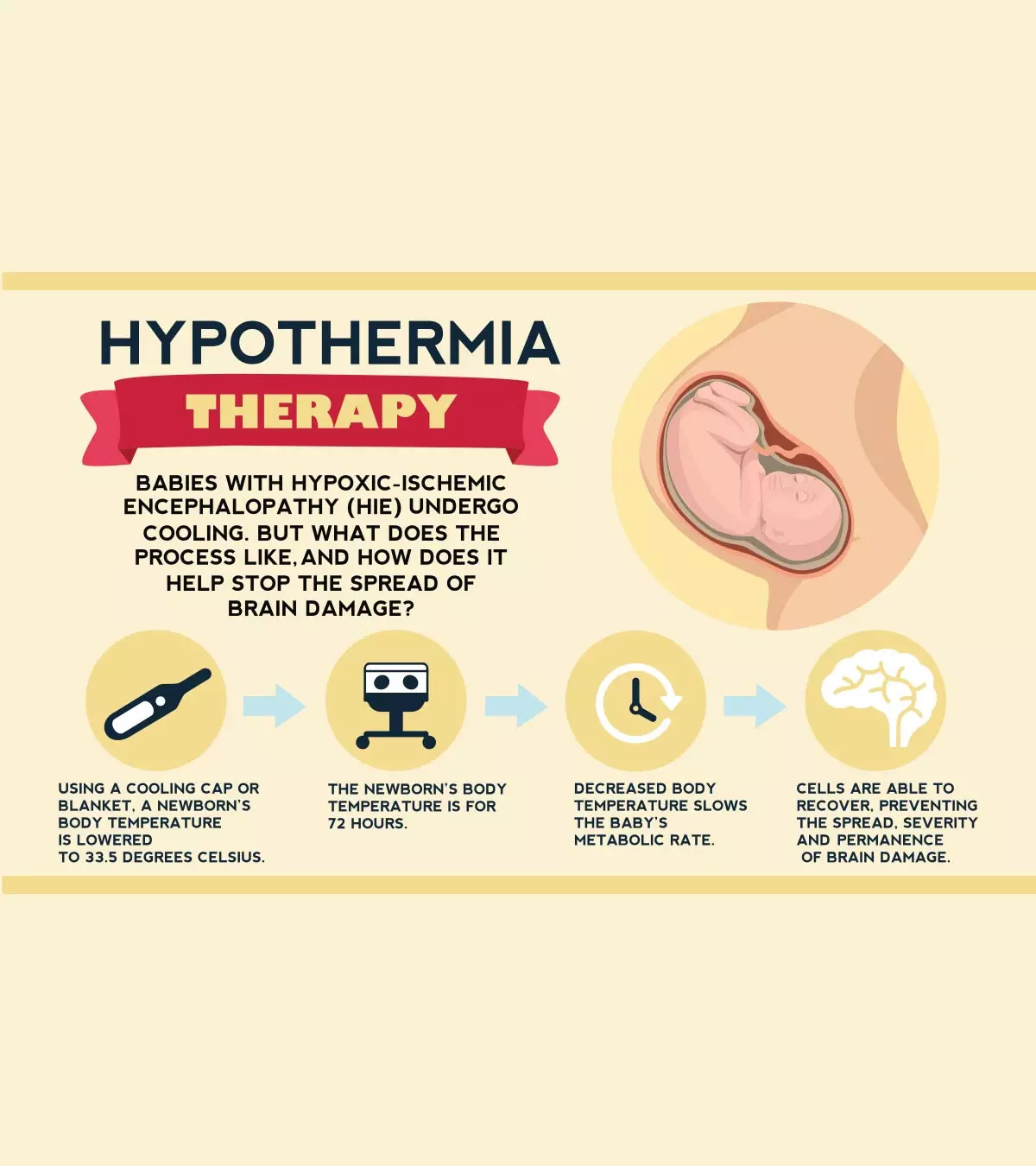

Image: Shutterstock
Hypoxic-ischemic encephalopathy (HIE) is a type of brain damage that could occur in infants due to insufficient oxygen and blood flow to the brain during pregnancy or delivery. HIE in newborns may vary in severity depending on the duration of oxygen deprivation.
HIE may cause disorders such as cerebral palsy, severe cognitive and motor impairment, and developmental delay. Although it cannot be completely cured, the present treatment options may improve the baby’s quality of life.
Keep reading this post to learn about the symptoms, causes, risk factors, long-term effects, treatment, and prevention of HIE in babies.
Signs And Symptoms Of HIE
The signs and symptoms of HIE are usually seen immediately after birth and may vary depending on the severity of the brain damage.
Mild HIE signs and symptoms may resolve within a week in many babies and may include the following (1).
- Abnormal reflexes
- Stiff muscles
- Feeding issues
- Excessive crying
- Irritability
- Excessive sleeping
Moderate HIE
may cause the following signs and symptoms(1).
- Floppy baby syndrome or hypotonia (reduced or lack of muscle tone)
- Sporadic apnea (sudden pause in breathing)
- Seizures within the first day of life
- Absence of reflexes
- Unable to grasp and often has a poor sucking reflex
Severe HIE could be
life-threatening and may cause the following signs and symptoms(1).
- Irregular breathing
- Increased frequency of seizures across two days
- Hypotonia, extreme lack of muscle tone may make the baby like a rag doll
- Dilated pupils
- Abnormal eye movement and control
- No reflexes
- Abnormal blood pressure
- Changes in heart rate
- Cardiorespiratory failure
The severity of brain damage may vary based on the time of hypoxia (oxygen deprivation). HIE before 35 weeks of gestation (premature) may result in periventricular leukomalacia (PVL). This condition causes the death of small areas of brain tissue around the brain’s ventricles (fluid-filled cavities).
The extent of the brain damage may depend on the severity and length of hypoxia, and the areas of the brain that are affected.
Causes And Risk Factors Of HIE In Newborns
Hypoxia(insufficient oxygen reaching tissues) and ischemia (inadequate blood flow to the tissues) cause encephalopathy (brain damage), leading to hypoxic-ischemic encephalopathy in babies. Loss of blood and poor oxygen supply to the brain during the birth process may result in HIE in babies. The incidence and severity of HIE may vary based on the duration of oxygen deprivation.
The following factors may increase the risk of hypoxia and ischemia in newborns (2).
- Acute onset of maternal hypotension (low blood pressure)
- Preeclampsia (high blood pressure)
- Cardiac problems
- Umbilical cord complications and cord prolapse
- Poor lung function
- Breathing interruptions
- Blood clotting abnormalities
- Fetal stroke
- Head injury during delivery
- Pressure on cranium due to molding during delivery
- Medical negligence during delivery, such as inappropriate use of forceps or vacuum-assisted delivery
- Intrapartumhemorrhage that is bleeding from onset of labor to the end of the third stage of labor
- Insufficient bloodflow to the brain during birth
- Placental abnormalities such as placental abruption
- Rupture of vasa previa (blood vessels trapped between the fetus and birth canal)
- Uterine rupture during the gestation period
- Fetal trauma
- Stress during labor and delivery
- Maternal infections, such as pelvic inflammatory disease
HIE is more common in full-term babies than in preemies. Full-term infants are more likely to develop hypoxic-ischemic encephalopathy during labor and delivery than pregnancy. Pregnancy-related complications could be a reason for HIE in preterm babies.
Long-Term Effects Of HIE In Babies
HIE may result in long-term physical and cognitive damage consisting of the following problems (3).
- Cerebral palsy
- Seizure disorders or epilepsy
- Hearing and vision loss or impairments
- Learning disabilities
- Speaking problems
- Walking and coordination problems
- Autism and autism spectrum disorders
Low mental development index (MDI) and psychomotor development index (PDI) due to HIE could also occur in some babies.
Diagnosis Of HIE
Neuroimaging, such as MRI scans, can diagnose hypoxic-ischemic encephalopathy. Other techniques, such as diffusion-weighted imaging and MR spectroscopy, could also be conducted (4).
The HIE diagnostic tests are often ordered if the birth was traumatic or there are significant risk factors for fatal stroke. Visible signs and symptoms, such as seizures, within 24 hours of life, organ dysfunctions shortly after birth, growth and developmental delay, and impaired motor function are also indications to do an MRI scan.
The severity of HIE is usually diagnosed at an age when the cognitive function can be assessed adequately. HIE can be mild, moderate, or severe. Some additional tests are often ordered to exclude the diagnosis of other metabolic and neurodegenerative disorders in babies.
Treatment Of HIE In Babies
There is no specific cure for HIE. Treatment options aim to relieve or ease symptoms of brain injury. Therapeutic hypothermia or cooling the body and head immediately after birth is one of the recent treatments for HIE. Cooling down the body temperature may reduce brain cell damage and death (5).
Although it’s relieved, oxygen deprivation may reoccur in some cases. The blood glucose levels and blood pressure are kept in normal range with medications to avoid further brain injuries and complications. Cerebral edema and seizures are also controlled or prevented with medications.
Physical and occupational therapies are often required to improve the quality of life. Babies with HIE may require medical support for a long time. The type of therapy and long-term support may depend on several factors, including the extent of brain damage, response to other treatments, and prognosis of complications.
Prevention Of Hypoxic-Ischemic Encephalopathy
Prevention of hypoxia and ischemia during pregnancy and delivery could prevent HIE in babies. The following factors may help to avoid HIE in babies.
- Parents and caregivers must be educated about the risk factors and early signs and symptoms of HIE.
- Adequate prenatal checkups and testing in case of problems should be conducted.
- Discuss any pregnancy-related or delivery-related risk factors and their resolution extensively with your healthcare provider.
- Electronic fetal monitoring during delivery by the doctor may help understand fetal distress and use interventions to enhance the delivery process.
Frequently Asked Questions
1. How long do babies with HIE live?
According to experts, 15-20% of newborns diagnosed with HIE don’t survive the first week. Of the remainder, one-fourth will suffer permanent damage to the brain to varying degrees of severity (5). Generally, babies with mild HIE survive and often don’t develop adverse or long-term effects. On the other hand, 30 to 50% of infants with moderate HIE develop more serious problems. In infants with severe HIE, the mortality rate is 25 to 50%, and out of those who survive, 80% develop serious complications (6).
2. Is HIE considered a disability?
HIE isn’t a disability in itself. However, depending on its severity, it can cause adverse complications, such as cerebral palsy that can disable a child.
3. Is HIE genetic?
Research shows that besides maternal factors, uterine environment, and labor process, HIE is also associated with congenital genetic factors (7).
HIE (Hypoxic-ischemic encephalopathy) in the newborn is rare but may lead to long-term issues. It could develop in babies due to blood loss or inadequate oxygen supply to the brain during delivery. HIE may lead to serious brain injuries, including physical and cognitive impairments and permanent brain damage when severe. However, appropriate treatment interventions could help recuperate babies with mild or moderate HIE. Therefore, it is crucial to talk to your healthcare provider about the possible risk factors for timely evaluation and preventing long-term complications.
Key Pointers
- Any hypoxic-ischemic event causes HIE during the prenatal or postnatal period that prevents the blood flow to the infant’s brain.
- Irregular breathing, increased seizures, and absence of reflexes can be signs of severe HIE in infants.
- Adequate prenatal checkups and fetal monitoring can help prevent the occurrence of HIE.
References:
2. Hypoxic Ischemic Encephalopathy: Pathophysiology and Experimental Treatments; US National Library of Medicine
3. Long-Term Outcomes of HIE; HIE Help Center
4. Hypoxic-Ischemic Encephalopathy; CerebralPalsy.org
5. HIE – Hypoxic Ischemic Encephalopathy; Birth Injury Help Center
Community Experiences
Join the conversation and become a part of our nurturing community! Share your stories, experiences, and insights to connect with fellow parents.
Read full bio of Dr. Misha Yajnik
Read full bio of Dr Bisny T. Joseph



















